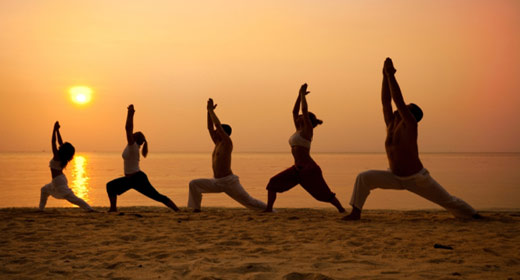by Karen Asp: Stretching might seem like a no-brainer activity, but there are some subtle nuances that can make all the difference in your results…
You know you need to stretch more. Effective stretching, after all, increases flexibility, which can help you maintain range of motion in your joints. “Having range of motion not only increases your performance in your workouts but also enhances daily life because you’ll be able to move better in everything you do,” says Frances Flores, NASM-certified personal trainer and yoga coach in Los Angeles.
Everyday activities, such as sitting or working out sans stretching, can shorten your muscles. Shortened muscles, in turn, decrease range of motion and can often trigger body aches and pains, Flores says. Yet by stretching, you keep your muscles long, healthy and strong — and become more mobile in the process.
Question is, though: How can you make those stretching sessions even more effective? Experts offer 10 tips:
1. Do dynamic stretches before a workout.
You probably think of stretches as those that you hold, and if you’re still following fitness practices from a decade ago, you might be doing them before your workout. But because your body isn’t warmed up yet, those stretches can strain your muscles or hinder your performance. Instead, swap static for dynamic stretches, moves that get your body warm and work on mobility, which you’ll need for your workout.
“Often, the moves you want to incorporate in dynamic stretching will be similar to the movements you’ll be doing in your workout,” Flores says. For instance, if you’re running, you might do dynamic quad hip stretches or standing dynamic bent-knee forward swings.
2. Save static stretches for after your workout.
After your workout is the time to do those held stretches. When you do physical activity, your muscles actually shorten when they contract, but by doing static stretching when warm, you can lengthen them again. Hold each stretch anywhere from 30 to 90 seconds.
3. Make sure stretches feel comfortable.
The point of stretching is to help avoid injury, but if you’re straining during that stretch, you could risk injury, says DJ Townsel, yoga instructor, NOW expert and former NFL player based in Orlando, Florida. If you feel any pain or discomfort, ease up on the stretch.
4. Think proper form and muscle engagement.
Just because you’re stretching your muscles doesn’t mean they’re at rest. “Touching your toes means nothing if the integrity of your spine is at risk during the stretch,” Townsel says. This often happens because of lack engagement of the core, he adds. Think about engaging your muscles and check that you’re using proper form. If you’re not sure, check out exercise videos or work with a personal trainer.
5. Take deep full inhales and deep full exhales.
By focusing on long inhales and exhales, “you send relaxation signals to your body that help your body ease into the stretch,” Flores says. That, in turn, will help you increase your range of motion during stretches. Use that exhale to help you get deeper in the stretch, letting your body relax with each breath you take.
6. Use props to aid your stretching.
You may have used props in yoga classes, but don’t discount their use when you’re doing traditional stretches. Those props can help you get deeper into a stretch without tensing your body, which would then defeat the purpose of stretching, Flores says. For instance, if you’re doing a hamstring stretch while lying on your back, you might have trouble reaching your foot, but by using a strap around the arch of your foot, you can get deeper into the stretch and relax the rest of your body. Yoga props — such as blocks, a strap, a blanket and bolster — make for great all-around props for effective stretching.
7. Start small.
Townsel stretches at least 20 minutes a day, but it wasn’t always like that. In fact, he began his stretching journey by doing short, five-minute stretches every morning to help with back and neck pain. As he began to realize the benefits, he gradually increased his stretching time.
8. Stay hydrated.
You know you need to up your water intake when you’re doing cardio workouts, but hydration is key for stretching, too.
“With stretching and other forms of recovery, you’re releasing toxins into the body that are stored in fatty and other connective tissue,” Townsel says. By drinking water, however, you can expel some of those toxins. Plus, the fluids you’re drinking will help your joints function better, which will make your stretching more effective, he adds.
9. Make stretching a daily habit.
Your body didn’t get tight overnight, and it won’t get loose overnight either. So start by stretching a little every day, Flores says.
10. Add a weekly yoga session.
Through yoga, you can further improve your range of motion and mobility and, over time, your flexibility. “Yoga will teach you how to contract and engage certain muscles, which allows you to relax and lengthen other muscles so you can properly stretch without getting injured,” Flores says.
An added bonus? While tightness in the body is often from physical causes, it also can be from past emotional traumas and daily stress and anxiety. Because yoga brings the body and mind into balance, you may have an easier time letting go of that tightness as a result.









































